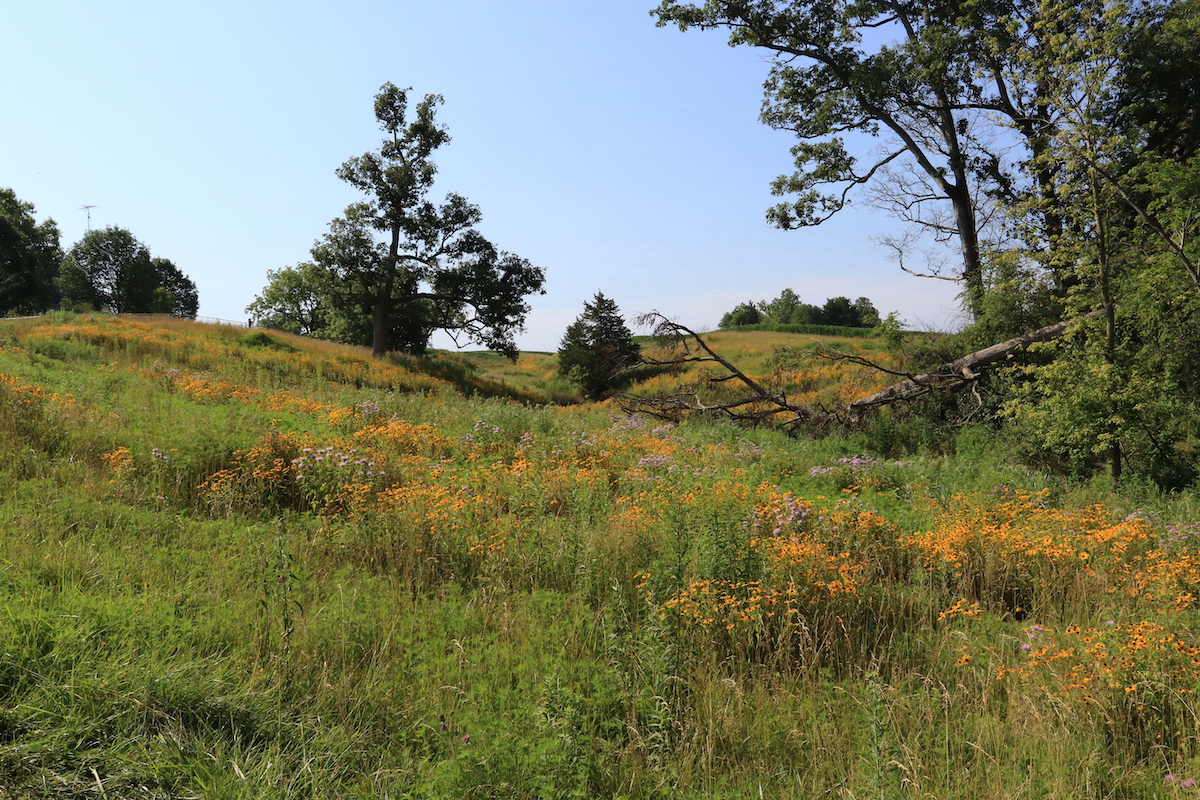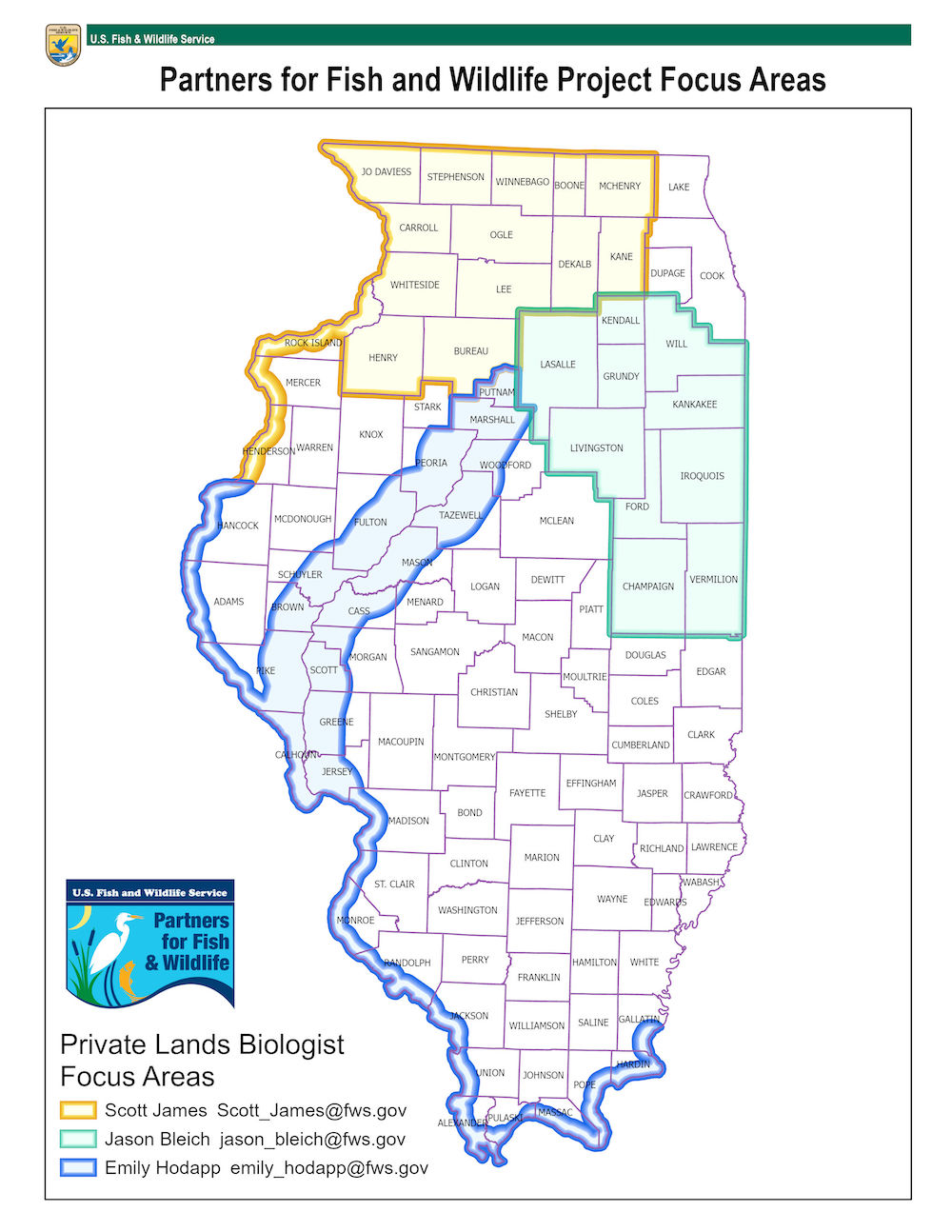
Upland prairie with summer blooms. All photos courtesy of the author.



Upland prairie with summer blooms. All photos courtesy of the author.

The U.S. Fish and Wildlife Service Partners for Fish and Wildlife Program (PFW) has supported the Illinois Conservation Reserve Enhancement Program (CREP) since its inception. The reopening of CREP enrollment provides the Illinois PFW program more opportunities to assist with a greater number of projects that conserve native vegetation, hydrology, and soils associated with imperiled ecosystems such as bottomland hardwoods, native prairies, marshes, rivers, and streams. The Illinois PFW program has been collaborating with private landowners in the Illinois and Kaskaskia River CREP areas to restore, enhance and preserve natural habitats. Benefits from this collaboration are the landscape scale enhancements of privately owned land for Federal Trust Species, such as migratory birds, endangered, threatened and at-risk species of plants and animals, as well as numerous state-threatened or -endangered species.
Within the Illinois and Kaskaskia River Watersheds, individual Partners projects compliment CREP and other habitat programs by providing tools for restoration and enhancement of habitats on lands that may not be eligible for other landowner assistance programs. In federal fiscal year 2020, the PFW program conserved 338 acres of wetlands and 43 acres of upland habitat within the CREP area. Many Partners for Fish and Wildlife projects take place on privately owned land previously enrolled in CREP.

In the northeast part of the state, Private Lands Biologist Jason Bleich, recently completed a wetland restoration with a private landowner to restore two prairie pothole wetlands that were drained in the early 1900s for agriculture production. The project site was enrolled in CREP by a former landowner. The new landowner wanted to restore the wetland basins for waterfowl and overall wildlife value. As part of the Partners program, a local contractor constructed a small earthen berm, installed a water control structure, and disabled old clay drain tiles. The landowner contributed to the project by removing scrub trees and spraying invasive reed canary grass and phragmites that had taken over the area. This Partners project restored 3.5 acres of wetland habitat which lies in the middle of 30 acres of native prairie. This summer, the project has already produced several broods of mallards, blue-winged teal and wood ducks.
In the Illinois River Valley, Private Lands Biologist Emily Hodapp is working with a private landowner to restore a semi-permanent wetland drained by early European settlers during colonization, likely in the late 1800s. The project site was enrolled in CREP by a former landowner and retired from agriculture use, but the natural hydrology of the site was not restored. As part of the Partners program, the ditches used to drain the wetland will be plugged and a water control structure will be installed to provide water level management capabilities. The Partners program will also assistant the landowner with removal of undesirable and invasive plants. When complete, this Partners for Fish and Wildlife project will have restored 38 acres of wetland habitat, which includes a semi-permanent wetland surrounded by native wet prairie. This restoration will benefit many native migratory ducks. During the dryer months, mudflat habitat created by lowering water levels will beneficial to a host of migrating shore birds including semipalmated sandpiper, pectoral sandpiper, Hudsonian godwit and short-billed dowitcher. Native moist-soil vegetation and prairie plants will support pollinating insects, including monarchs, and provide critical foraging habitat for insectivorous species such as the threatened northern long-eared bat and endangered Indiana bat.

Partners projects also occur in uplands areas throughout the PFW focus areas. Scott James, Private Lands Biologist out of Moline is assisting private landowners in northwest and north-central Illinois with upland prairie restorations to benefit the federally endangered rusty patched bumble bee. Jason Bleich is planning an oak savanna restoration project with the Friends of Kankakee and the Illinois Nature Preserves Commission. Emily Hodapp just started a project in the Kaskaskia watershed to enhance acreage enrolled in CREP by removing invasive species and undesirable trees to convert degraded grasslands into highly diverse prairie and open canopy woodlands with assistance from the Trees Forever Illinois Buffer Program. Restoring native upland prairies and oak savanna benefits numerous native wildlife including pollinators, bats, white-tailed deer, wild turkey, and quail, but will also help reduce erosion and sedimentation into the Illinois and Kaskaskia river systems. Removal of the woody vegetation and restoration of native grasses and flowers allows rain water to better absorb into the ground, reducing runoff and increasing water quality.

If you own land previously enrolled in Illinois Conservation Reserve Enhancement Program or plan to enroll in the newly opened CREP, reach out to your local Partners for Fish and Wildlife Private Lands Biologist. The Partners for Fish and Wildlife program provides free technical assistance and may be able to assist with funding for restoration or enhancement projects within a Private Lands Biologist focus area. Biologists are able to support projects outside of their focus areas, but only for great projects, such as those mentioned in this article. Check out the map above for your local Partners Biologist’s focus area and contact information.
Emily Hodapp is a Private Lands Biologist for the U.S. Fish and Wildlife Service in Illinois. Hodapp works with conservation partners and landowners throughout the Illinois and Mississippi rivers areas to produce more duck food while also promoting Boltonia decurrens, a federally threatened plant species. In addition to her work on the rivers, she tackles hill prairie restorations which benefit the monarch butterfly, pollinators, northern bobwhite, migratory songbirds and more. She also works with private landowners to restore ephemeral wetlands for breeding Illinois Chorus Frogs, migrating waterfowl and quail.
Submit a question for the author